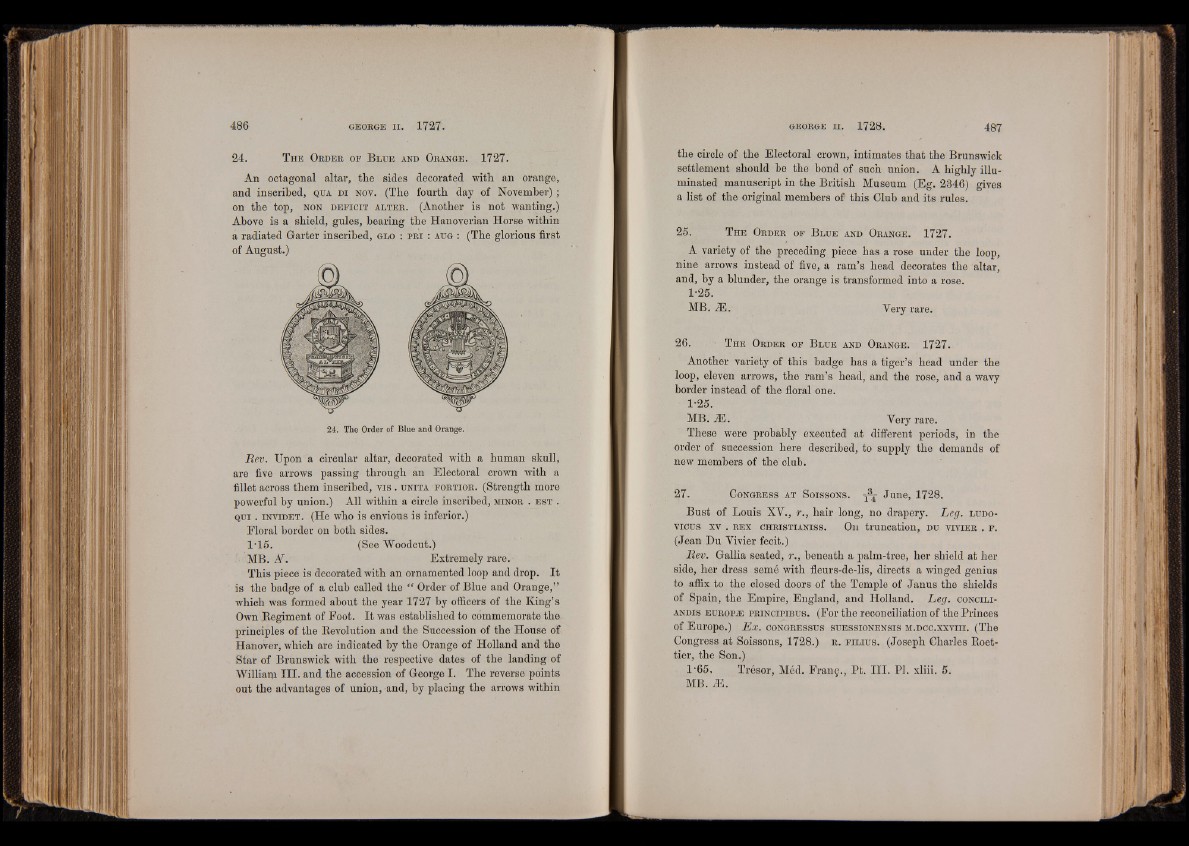
24. T h e Or d e r o f B l u e and Or a n g e . 1727.
An octagonal altar, the sides decorated with an orange,
and inscribed, qua d i n o y . (The fourth day of November);
on the top, non d e f ic it a l t e r . (Another is not wanting.)
Above is a shield, gules, bearing the Hanoverian Horse within
a radiated Garter inscribed, g lo : p r i : aug : (The glorious first
of August.)
0) (0
24. The Order of Blue and Orange.
Rev. Upon a circular altar, decorated with a human skull,
are five arrows passing through an Electoral crown with a
fillet across them inscribed, vis . u n i t a f o r t i o r . (Strength more
powerful by union.) All within a circle inscribed, m in o r . e s t .
Q u i . i n v i d e t . (He who is envious is inferior.)
Floral border on both sides.
1-15. (See Woodcut.)
MB. N . Extremely rare.
This piece is decorated with an ornamented loop and drop. It
is the badge of a club called the “ Order of Blue and Orange,”
which was formed about the year 1727 by officers of the King’s
Own Regiment of Foot. It was established to commemorate the
principles of the Revolution and the Succession of the House of
Hanover, which are indicated by the Orange of Holland and the
Star of Brunswick with the respective dates of the landing of
William III. and the accession of George I. The reverse points
out the advantages of union, and, by placing the arrows within
the circle of the Electoral crown, intimates that the Brunswick
settlement should be the bond of such union. A highly illuminated
manuscript in the British Museum (Eg. 2346) gives
a list of the original members of this Club and its rules.
25. T h e Or d e r o f B l u e and Or a n g e . 1727.
A variety of the preceding piece has a rose under the loop,
nine arrows instead of five, a ram’s head decorates the altar,
and, by a blunder, the orange is transformed into a rose.
1-25.
MB. Æ. Yery rare.
26. • T h e Or d e r o f B l u e and Or a n g e . 1727.
Another variety of this badge has a tiger’s head under the
loop, eleven arrows, the ram’s head, and the rose, and a wavy
border instead of the floral one.
1-25.
MB. Æ. Yery rare.
These were probably executed at different periods, in the
order of succession here described, to supply the demands of
new members of the club.
27. C o n g r e s s a t S o is s o n s . June, 1728.
Bust of Louis XV., r., hair long, no drapery. Leg. l u d o -
v ic u s xv . r e x c h r is t ia n is s . On truncation, d u v iv ie r . f .
(Jean Du Vivier fecit.)
Rev. Gallia seated, r., beneath a palm-tree, her shield at her
side, her dress semé with fleurs-de-lis, directs a winged genius
to affix to the closed doors of the Temple of Janus the shields
of Spain, the Empire, England, and Holland. Leg. c o n c il i-
a n d is e u r o pæ p r in c ip ib u s . (For the reconciliation of the Princes
of Europe.) Ex. c o n g r e s su s s u e s s io n e n s is m .dc c .x x v i i i . (The
Congress at Soissons, 1728.) r . f i l iu s . (Joseph Charles Roet-
tier, the Son.)
1-65. Trésor, Méd. Franç., Pt. III. PI. xliii. 5.
MB. Æ.